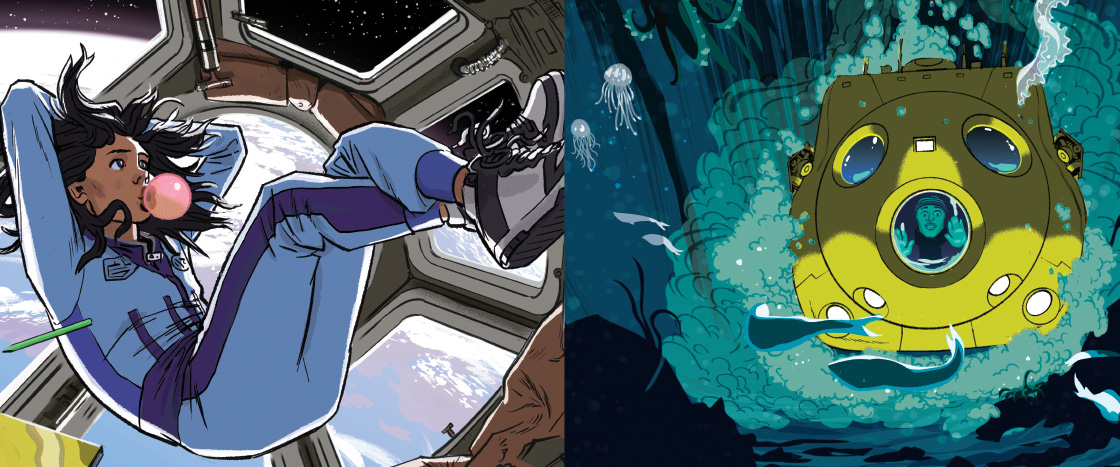The International Space Station (ISS) is an enormous science lab orbiting Earth. The Mariana Trench, in the Pacific Ocean, is the deepest point on Earth. If you could visit either space on the ISS or the ocean’s depths in a submersible, which would you choose?

Would You Rather Visit Space or the Deep Sea?
If you could visit either space on the ISS or the ocean's depths in a submersible, which would you choose?
Learning Objective: Students will gather and use information about the International Space Station and Mariana Trench to support an argument.
Standards
IN SPACE: International Space Station, Low Earth Orbit
STUDIOLABDEV/TURBOSQUID
The ISS orbits Earth at a whopping 18,000 miles per hour!
WHERE TO STAY
The ISS orbits Earth about 250 miles (402 km) above the ground. It’s almost the length of a football field, with small sleeping cabins, two bathrooms, a gym, and several science labs.
TRAVEL PARTNERS
Six astronauts are typically aboard the ISS at any given time. They could come from Canada, Europe, Japan, Russia, or the U.S.
POSSIBLE CHALLENGES
On the ISS, there’s almost no gravity. You’d always be floating! You’d need to strap yourself down to sleep, eat, and use the bathroom. You might also lose muscle from not walking.
WHAT YOU'D YOU SEE AND DO
NASA
Scientists do a lot of research on the ISS so you’d likely spend most of each day doing science experiments. You might try to grow plants in low gravity, or test a new robot. You could also be sent outside the station for a spacewalk to help with repairs. In your downtime, you might take a moment to gaze out the window. You’d have a clear view of thousands of stars and our beautiful blue planet!
IN THE DEEP SEA: Mariana Trench, Western Pacific Ocean
Illustrated by Jeff Mangiat and Magictorch
WHERE TO STAY
You’d need a powerful submersible to dive this deep–like the Limiting Factor! Its walls are 3 inches (8 cm) thick and made of a strong metal called titanium.
TRAVEL PARTNERS
The Limiting Factor is only big enough to hold two people. But you’d also need a ship to transport your sub to and from the trench. You’d likely have about two dozen crewmates.
POSSIBLE CHALLENGES
The force of water pressing down at the bottom of the trench is 1,000 times greater than that of air at sea level. If your submersible were damaged even a little, it could collapse and crush you instantly.
WHAT YOU'D YOU SEE AND DO
© 2005 MBARI
Sea pig
No sunlight reaches the floor of the Mariana Trench. You’d see only what your sub’s lights shine on. You might use your sub’s robotic arm to collect a sample of the sandy seafloor to study. With luck, you might see creatures like glowing comb jellyfish, pink sea pigs, or large, shrimplike critters called amphipods. So much is undiscovered here—you might even find a new species! You’d return to the surface in a few hours.
Which would you rather visit?
Which would you rather visit?
Which would you rather visit?
1. PREPARE TO READ (10 minutes)
Make an initial choice and explain the reasoning behind it.
- Tell students: Imagine you could travel to outer space or to the bottom of an ocean trench (a very deep, narrow valley on the seafloor). Tell them to close their eyes and imagine they are being launched into space in a rocket or sinking to the bottom of the ocean in a small submersible.
- Then ask: Would you rather visit space or the deep sea? (If needed, explain the “Would You Rather...?” game. In this game, a person must make a tricky choice between two things. There isn’t a “right” answer, but you should be able to defend your choice.) Let students record their initial choice and jot down one or two sentences about the reasoning behind their decision.
- Play the video “Would You Rather Visit Space or the Deep Sea?” Give students time to change their choice and/or add any new information from the video to their reasoning. Designate one side of the room “visit space” and the other side “visit the deep sea.” Tell students they’re allowed to change their mind later, but for now they should go to the side that matches their choice. Tally up each side and record it on the board. Have students return to their seats.
2. READ AND EVALUATE (15 minutes)
Gather information and discuss text evidence.
- Read the article aloud or have students read it independently. Ask: What information did you find most surprising or interesting? Let students discuss in pairs. Then reconvene as a class and ask for volunteers to share. Compare sections with the same titles, like “Where to Stay” and “Travel Partners.”
- Ask students: Did your original choice change? Why or why not? Remind students that new information could change one’s mind—and that’s okay! As we learn more, our thinking often changes!
3. RESPOND TO READING (20 minutes)
Write and evaluate an evidence-based opinion.
